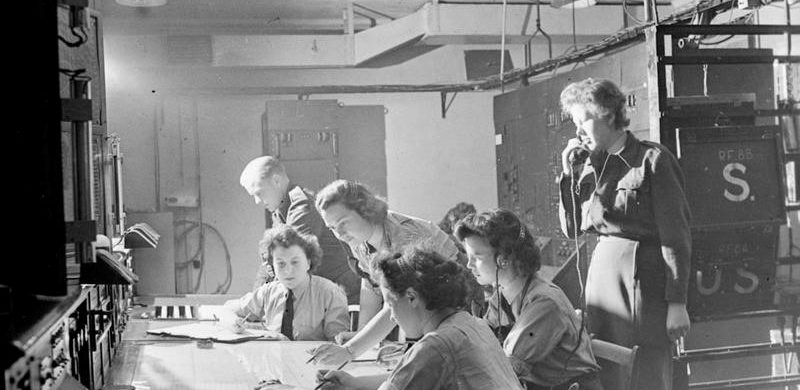
Dreams and Visions: The Development of Military Radar Iconography and User Reaction, 1935-45
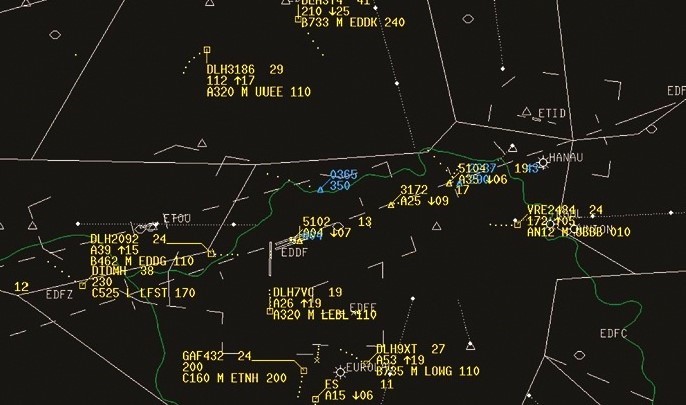
Figure 1. Typical modern ‘map-like’ air traffic radar display showing details of all aircraft within range (Image credit: https://aviation.stackexchange.com/questions/12327, downloaded January 3, 2020, 0800 GMT
Technology’s Stories v. 8, no. 1 – DOI: 10.15763/jou.ts.2020.06.08.04
PDF: Judkins_Dreams and Visions
War, the pursuit of power through conflict, needs ways to ‘see’ an enemy, even if that enemy is beyond visual range, or is invisible due to night or bad weather. After 1935, those constraints began to be overcome in real-time by radar [1]. This posed two inter-related challenges; scientifically, the design of a radar display identifying an invisible foe and their location was a non-trivial challenge – but also, in parallel, ‘a way to see the enemy’ is psychological. To quote Cristina Masters [2], ‘death is a dot on a screen’; did killing then in some sense become more acceptable? How did design, use and user interact? Memoirs and oral histories show, for different reasons, little psychological impact of displays on commanders or face-to-face combatants, but the rapid expansion of radar drew into the killing process one little-studied group, the first female radar operators, and further research is needed to identify their reactions.
Early radar user needs
Today’s radar displays are typified by Figure 1, showing, on a real-time map of airspace, every aircraft in range, detailing type, location, height and speed. Rises in processing power, and studies of iconography and human-computer interaction since 1945, have made such a presentation possible. However, the electronic technology available to early radar scientists could create only a line or a dot on a cathode-ray tube screen, as in Figure 2.
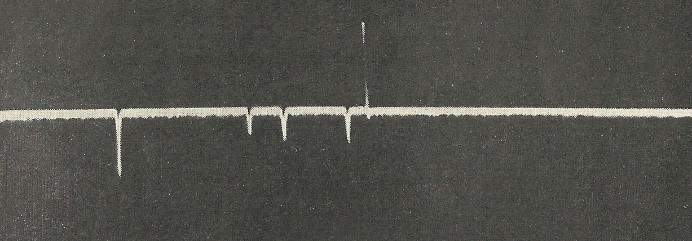
Figure 2. Screen display of British 1940 ‘Chain Home’ radar, showing four aircraft represented by downward-pointing ‘blips’. The upward-pointing trace is a marker which can be moved along by turning a pointer moving over a scale which shows the target’s range. (Image credit: Plate V, J.G Crowther and R Whiddington, Science at War, London: HMSO, 1947; Crown Copyright now expired)
The early users of radar across all nations were military, and among them there can be identified two distinct user groups – commanders and combatants – each with different needs. A commander needed early warning of where the enemy were, where they were going and how many there were. The displays for commanders, now fed by radar data, took the traditional form of maps with suitable markers, familiar from the First World War and earlier. By contrast, combatants required real-time position, course and speed of a fast-moving nearby target, and its identification as friend or foe. Combatants’ radar displays would not only be novel, as was radar itself, but also necessarily intuitive, for in combat, the time to assimilate display information was, quite literally, a matter of life or death.
International comparisons
Alan Beyerchen [3] suggests that the employment of radar across nations varied according to national priorities; interestingly, the displays of commanders varied likewise.
In post-1935 Britain, the national priority was early warning of air attack. Britain’s ‘Chain Home’ early-warning radar displays showed the target as a blip along a horizontal trace (Figure 2), and range could be read from an illuminated scale; further readings gave target bearing and height. By 1939, integrated displays had been developed to show whether an aircraft was friend or possible foe, and, if friendly, whether it was in distress, by pulsing the target blip either in height or in width. The data thus gained by each radar operator was then, after filtering to remove anomalies, aggregated with that from other radars, and presented for commanders as counters on a table map, showing numbers and height. Such a 1940 commander’s display mirrored that of Britain’s 1918 air defence [4]; since there was no change in data presentation, one may reasonably assume there was none in the psychological effect on the commander, and their memoirs support that assumption [5].
By contrast, Germany’s first operational military radars, the longer-range Freya and the shorter-range Wurzburg, had been developed, not for early warning, but for gunnery – Freya for coastal artillery, Wurzburg for anti-aircraft guns [6]. As a result, both incorporated methods of more accurate ranging – for example, the Wurzburg radar’s display traces the perimeter of its display screen, and so was over three times as long as the British trace across the screen’s diameter (Figure 3).
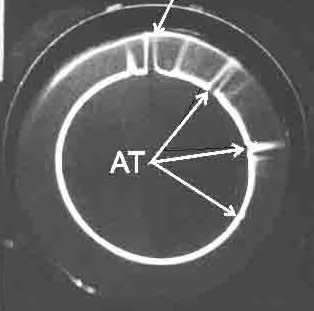
Figure 3: Circular display of German Wurzburg radar; AT marking target ‘blips’ (Image source: www.cdvandt.org with permission)
Adapted to serve in air defence, the data was used to populate a commanders’ traditional map presentation, later using optical projectors to shine data onto a vertical map as described below.
The USA, not a combatant until late 1941, possessed early-warning radar, but saw itself as beyond the range of air attack. No ‘Identification Friend or Foe’ system had been integrated with its early warning displays. The carrier-borne Japanese aircraft attacking Pearl Harbor in December 1941 were tracked by US radar, but, as aircraft deliveries from mainland USA to Hawaii were expected, the radar display blip of the attackers was assumed friendly [7]. The consequences for Pearl Harbor brought the USA into war.
Wartime display developments.
During 1940, British display development created the Plan Position Indicator (PPI), the radar displays familiar today, in which a map-like presentation is regularly refreshed by a radial ‘clock-hand’ sweeping around its centre [8]. As distinct from today’s clarity (Fig. 1), the reality in 1940 was a series of smudged ellipses (Fig 4), but from them an experienced controller could guide an interception.
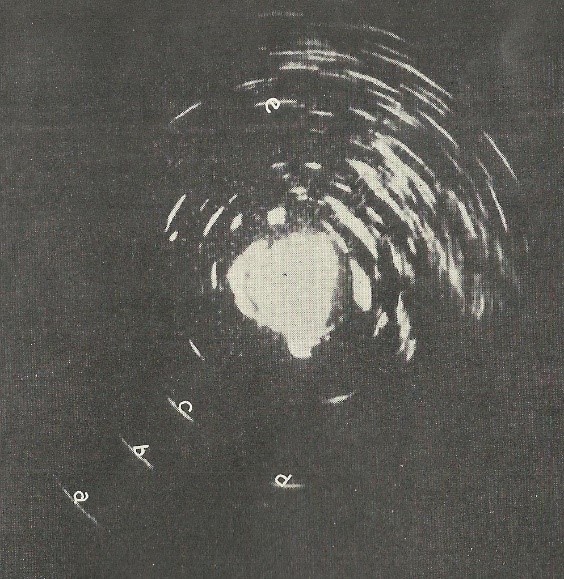
Figure 4. Plan Position Indicator (PPI) display; blips marked a, b, c, d, are target aircraft. (Image credit: Plate VID, J.G Crowther and R Whiddington, Science at War, London: HMSO, 1947; Crown Copyright now expired)
This British solution involved introduction of a new type of radar; by contrast, its German counterpart processed the data from existing radars in a new way [9]. Data from two Wurzburg radars went to light-projector operators beneath a screen (Fig 5); each operator shone a point of light – one blue, one red, to distinguish intruder and interceptor – onto the screen. The fighter controller looked down on the screen, and guided the intercepting fighter by radio.
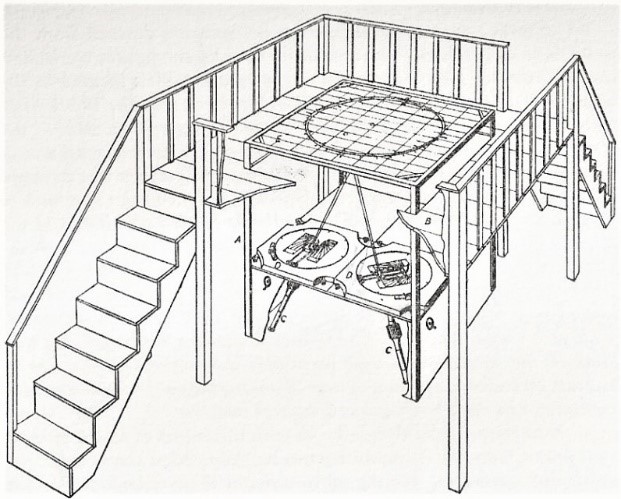
Figure 5. German plotting table (‘Seeburg’ table). (Image credit: uk National Archives, file AIR 20/1640, Figure 4. Crown Copyright, now expired)
To the ‘commanders’ user-group, therefore, radar was essentially a metatechnology, a new sensor feeding traditional displays; unsurprisingly, the memoirs of commanders show no indication of any changed psychological view of the enemy. To the combatant user-group, their radar displays now considered were totally novel, and part of life and death decisions.
Combatant radar.
The earliest combatant radar was an airborne ship detection radar, known as ASV (air to surface vessel) radar. British scientists, the first to create this type of radar, had developed three display possibilities [10] – side-scan; range-azimuth, the target shown by minimum signal; and a vertical trace, where the height of the target blip above the base shows range, and its displacement left or right of the centre vertical trace shows whether the target is to the port or starboard of the aircraft in which the radar is fixed (Fig.6).
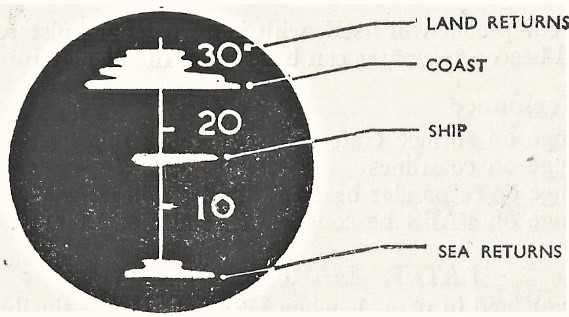
Figure 6. Early ASV radar trace (Image credit: Air Ministry, Air Publication 1093 D Introductory survey of radar principles and equipments, London, 1947, Part II Vol 1 Chapter 2 Figure 15, Crown copyright now expired)
The choice between the three was not made on psychological grounds, but on practicalities; side-scan lay beyond then-existing technology, while range-azimuth was ruled out due to inadequate range performance [11].
The second application of radar to combat was to air-to-air interception (AI) at night, a more complex three-dimensional situation – the enemy aircraft may be above or below, to the left or right of, and at unknown range from, the radar-equipped interceptor. These had to be crystallised into two dimensions for display. The British developed a two-tube display, following their ASV pattern [12]. Here, one tube displayed bearing, and one elevation, as shown in Figure 7. The bearing tube followed ASV symbology, while the elevation tube showed target height relative to the radar-equipped fighter by the blips projecting above or below the horizontal trace.
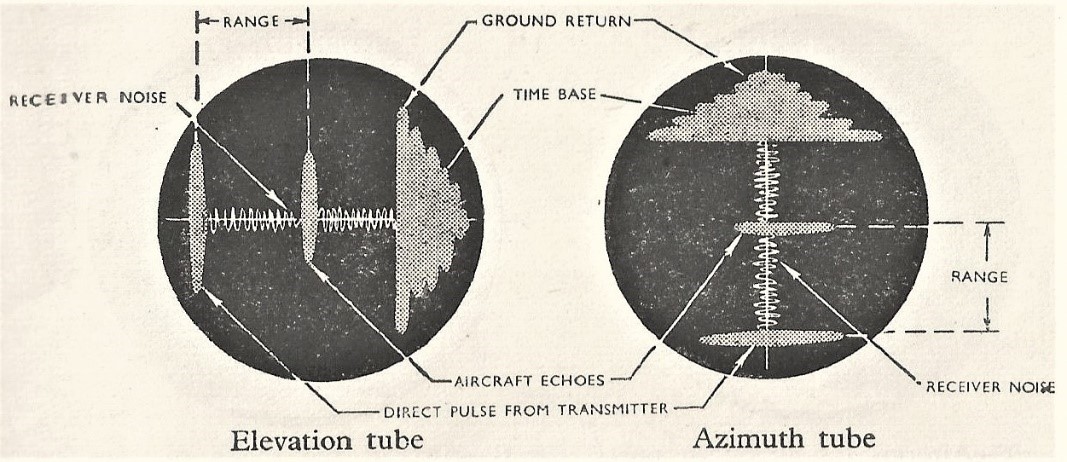
Figure 7. Early Air Interception (AI) display screens. (Image credit: Air Ministry, Air Publication 1093 D Introductory survey of radar principles and equipments, London, 1947, Part II Vol 1 Chapter 1 Figure 3, Crown copyright now expired
This being the first airborne interception radar, its display was emulated by other nations. Its drawback, however, was that such a display needed an operator aboard the fighter in addition to the pilot, incurring extra weight and thus loss of speed. Was a ‘lone pilot display’ possible?
British scientists, again the first to consider the problem, developed the display of Fig. 8 – two illuminated markers at the height of the interceptor, two vertical bars, and a U-shaped character, inscribed on an illuminated graticule in front of the radar display tube [13].
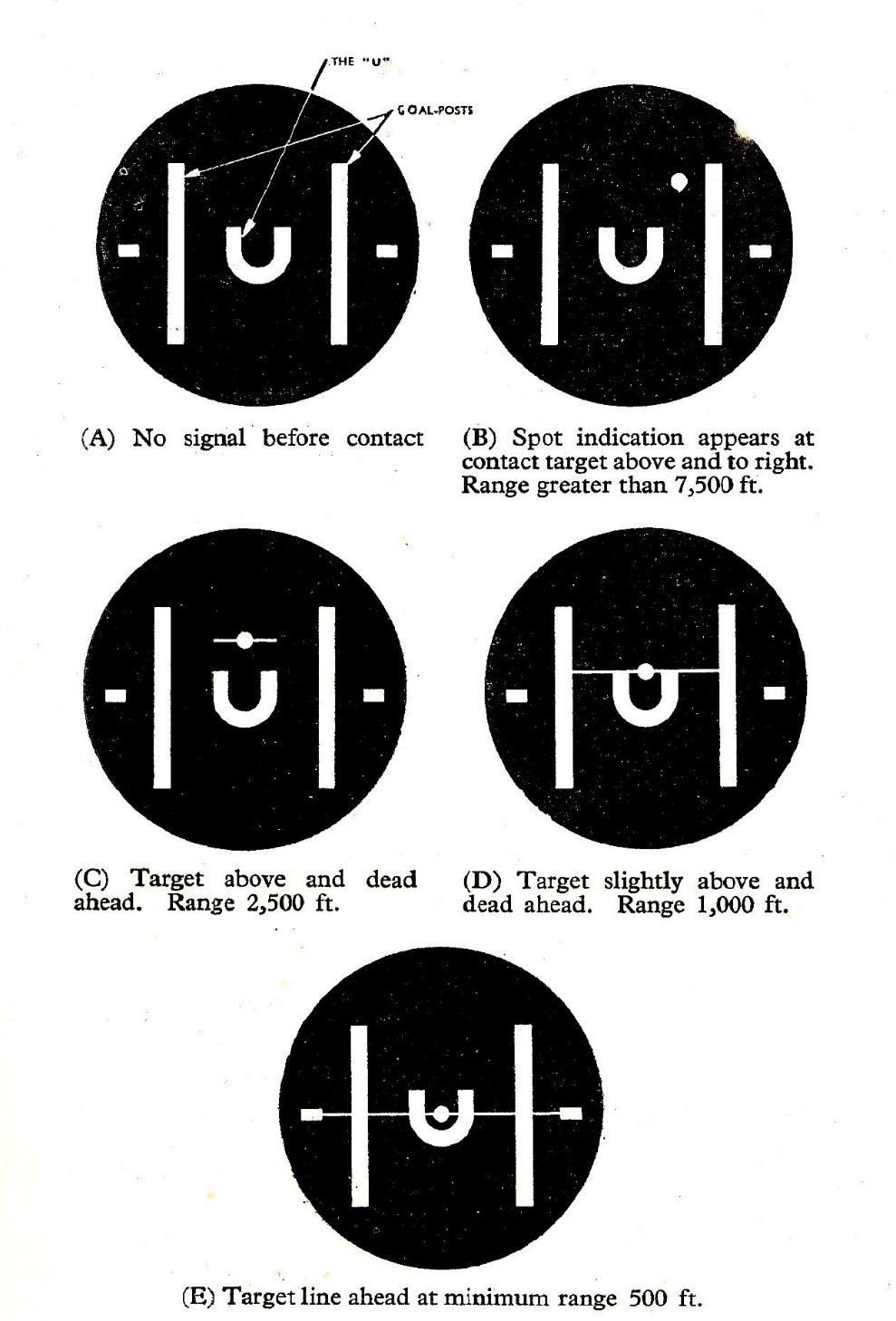
Figure 8. Pilot display for single-seat fighter (Image credit: Air Ministry, Air Publication 1093 D Introductory survey of radar principles and equipments, London, 1947, Part II Vol 1 Chapter 1 Figure 8, Crown copyright now expired)
The target is initially represented by a dot; then, as the interceptor closes in, the target dot grows small green ‘wings’. When these ‘wings’ intersect the vertical bars, the target range is 1,000 ft (300 m) range; when the wings extend to intersect the outer markers, 500 ft (150m).
Given the limited technology of the period, this display might be thought to have moved a considerable distance beyond ‘a blip on a line’, but even this ingenious system was overtaken by a technological leap.
In February 1940, the British produced what was rapidly to become an extremely compact, robust transmitter valve, the ‘resonant cavity magnetron’ [14], which generated powerful electromagnetic pulses at centimetric wavelengths.
One practical result was that radar aerial sizes could become as small as today’s satellite dish, and so able to be mounted in any aircraft or ship, or indeed many military land vehicles. A further result was that such aerials could now focus and project a narrow beam of energy, and given that the aerial could be rotated, that beam of energy could perfectly match a PPI display.
Consequently, a new generation of combatant radars was born, in which, as the operator was at the centre of the display, that display was inherently more intuitive than ‘blip on line’ displays. In Fig. 9, a display of the Elbe/ Weser/ North Sea area on such a radar; an airborne radar codenamed ‘H2S’ used in bombers employed this display.
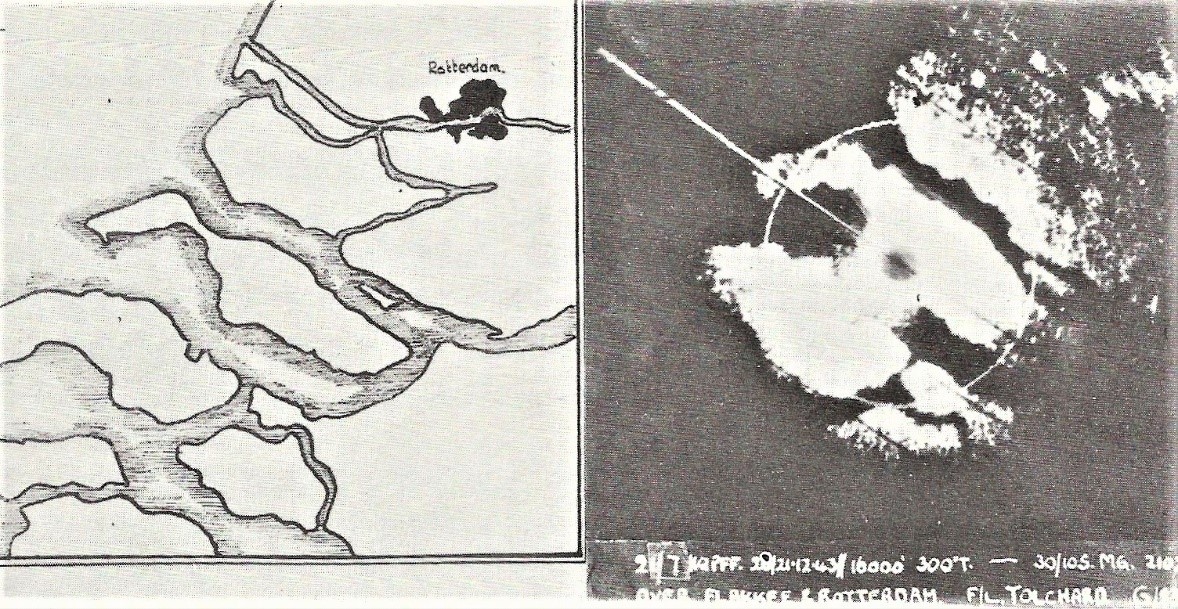
Figure 9. 1944 ‘H2S’ radar Plan Position Indicator (PPI) display of the area around the island of Goeree – Overflakkee, Netherlands, compared to a map of the same area (Image credit: Brian Johnson, The Secret War, (London: BBC, 1978) p101, original image Crown Copyright, now expired)
Similar PPI displays in aircraft of all types, on warships, and in Army anti-aircraft radar, replaced the older ‘blip on line’ presentation.
American and British displays followed similar practice, information being more or less openly exchanged between these Allies. In Germany, an early-war ill-advised decision, to halt long-range research, meant that only after 1943 did Germany adopt magnetron technology, copying Allied equipment and displays: thus, the British H2S radar was copied and adapted as the German Berlin [15].
Combatant memoirs show few psychological consequences from the developing nature of radar displays, as distinct from much impatience with the inadequacies of the early radars and frustration with electronic malfunctions [16]. A reasonable hypothesis might be that it is the role of combatants to destroy the enemy by whatever means are to hand, and that combatant training is directed to that same end, the integration of electronics into the killing process might be expected to have little impact, as the memoirs bear witness.
The advent of robotic warfare.
In mid-1940, Britain passed cavity magnetron technology to the USA [17], which considerably refined its design for ease of production, and developed many improved radars, including the war’s outstanding mobile radar, the SCR-584, a gunnery radar which had displays both of PPI for target acquisition, and a refined scale for range precision to ensure accurate gunnery. This new radar, shipped to Britain, countered two waves of assault by a new technology, self-guided missiles; robotic warfare was now at hand.
The first manifestation of these was in June 1944; the V-1 cruise missile, fast, internally guided and launched mainly against London and Antwerp, flew a straight and level course at low altitude, instantly recognisable on radar screens [18]. The SCR-584’s radar operators could ‘lock’ their radar to track such a missile, and their radar could be coupled to a mechanical calculator and servo-motors to both aim and lay anti-aircraft guns automatically. Robotic warfare now became a reality; the human ability to select a target by its flight characteristics was initially important, but once ‘locked on’, the radar then became both self-directing and the controller of the guns.
The second wave of missile attack came in September 1944, when the V-2 ballistic missile was launched against Britain [19]. Its flight was supersonic and no defence by gunnery was practicable without causing disproportionate damage to civilians; at that date, there were no anti-missile missiles capable of intercepting rockets. In the defensive system which evolved in this case, radar operators (Figure 10) identified the missiles by their upward hyperbolic tracks and extreme speed, switched in a very fast photo processor so as to trace these tracks backwards to reveal the missile launch sites, and called down upon them attack by Allied fighter-bombers.
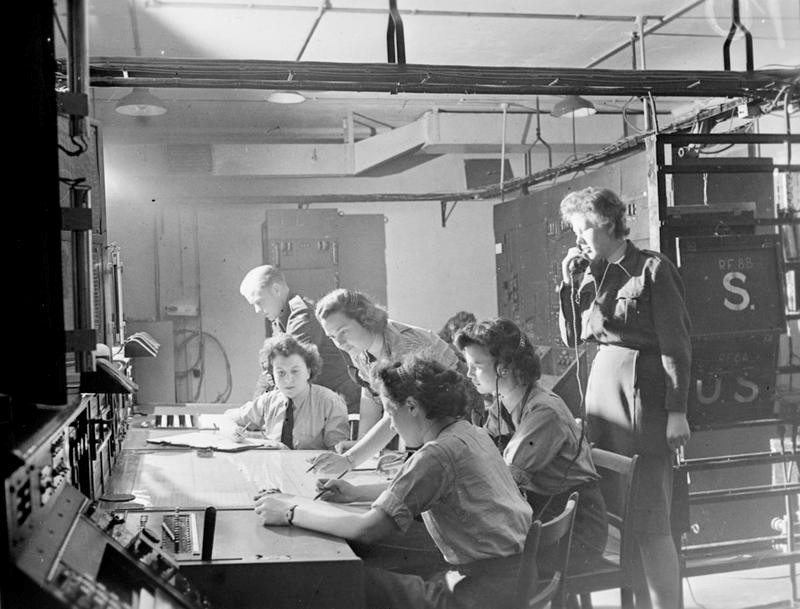
Figure 10. WAAF radar operators (Image credit: Photograph CH 15331 of the Imperial War Museums. Copyright (c) IWM CH15331, Non-commercial Use, https://iwm.org.uk/collections/item/object/205210716
Memoirs and oral histories, and even cartoons of the time, witness that the drone of the V-1 cruise missile certainly had a psychological impact upon those it targeted [20]; the supersonic V-2’s impact lay in the fact that there was no defence against it. It is the impersonality of these missiles which figures in oral histories and memoirs as their major psychological effect, resulting in a strong motivation to ‘destroy the machines’.
A new group of combatants?
While any psychological effects on commanders of radar-fed map displays might be assumed to be minimal, the commanders’ displays being of a traditional sort, and the effects on combatants similarly minimal – combatants being selected and trained to kill regardless of the presence or absence of electronics – it should be noted that both in Britain, and later in Germany, radar had now brought a new group of ‘quasi-combatants’ into the killing process – radar operators.
In Britain, these were often young women selected for their intelligence [21], a group not previously involved in combat death. The relatively few British radar operator memoirs contain even fewer tales of psychological impact; where mentioned, most comments are of emphatic commitment to homeland defence, or of empathy towards pilots in distress.
One account specifically mentions an organisational response to potential emotional reaction to involvement in the killing process, in this case through a senior commander addressing a group of young women radar operators selected to work on a system aiding bomber navigation to targets [22]:
“He then did something which I found rather touching. He explained that bombers being in the business of killing people, we might possibly have some kind of conscientious objection to being directly involved in this, and that if any of us had strong feelings about it, we could be excused at this stage and would be returned to the place from whence we came. And no hard feelings.
There was a total hush in the room. Nobody moved and nobody spoke.
Within an hour we were in the classroom learning all about it”.
The only apparent objection was that the women felt the work far more boring than fighter control radar [23].
By 1944, with the advent of robotic warfare in its initial phase of assault by cruise missiles, radar operator memoirs comment on their intense desire to destroy the ‘soulless’ missiles. It may be noted that, by that time, many British anti-aircraft gunners were also young women. Their psychology, as revealed by their memoirs, display similar sentiments.
Uniquely, one early postwar Battle of Britain film, 1952’s ‘Angels One-Five’, was written by a former radar observer. Social historian Angus Calder notes its depersonalisation [24]:
“There is no suggestion that this battle belongs solely, or even chiefly, to the young ‘Knights of the Air’. What is foregrounded is … Method, based on “radiolocation” (radar). … There are only brief … episodes in the air: we see much more of the Ops Room. The Ops Room … plot accurately the course of battle. The Ops Room guides pilots … to their targets.”
Commanders and combatants did not need electronic dots on screens to make death acceptable to them; the psychological impact may have been more on the new combatants, radar operators, very many of whom were female.
At present, this article is a report of work in progress; relatively few memoirs appear to survive further to validate user psychological reaction. The author would be delighted to hear from researchers in this field.
Suggested Readings.
- Louis Brown, A Radar History of World War II: Technical and Military Imperatives, (Bristol and Philadelphia: Institute of Physics Publishing, 1999).
- E.G. Bowen, Radar Days (Bristol: Adam Hilger, 1987).
- Fritz Trenkle, Die Deutschen Funkmessverfahren bis 1945 (Heidelburg: Huthig, 1986).
- Daphne Carne, The Eyes of the Few, (London: Macmillan, 1960).
- Gwen Reading, Radar Days, (Bognor Regis, UK: Woodfield Publishing, 2000).
Notes.
- Sean Swords, Technical History of the Beginnings of Radar (London: Peter Peregrinus, 1986), Chapter 4, 82-147.
- Cristina Masters, Bodies of Technology, International Feminist Journal of Politics, 2005, 7:1, 112-132, DOI: 10.1080/1461674042000324718
- Alan Beyerchen, ‘On Strategic Goals as Perceptual Filters: Interwar Responses to the Potential of Radar in Germany, the UK and the US’, in O. Blumtritt, H. Petzold and W. Aspray, (Eds.), Tracking the History of Radar, (Piscataway, New Jersey, USA: IEEE-Rutgers Center for the History of Electrical Engineering and the Deutsches Museum, 1994), 267-283.
- Major-General E.B. Ashmore, Air Defence (London: Longmans, Green, 1929), 92-96.
- For example, in the memoirs of Joubert, the commander responsible for radar during the early months of the war, there is great emphasis on improving the speed at which radar data was validated and transferred to the Operations Room table, but no mention of screen displays: Air Chief Marshal Sir Philip Joubert de la Ferté, The Fated Sky, (London: Hutchinson, 1952) 165-6.
- Fritz Trenkle, Die Deutschen Funkmessverfahren bis 1945 (Heidelburg: Huthig, 1986), 41-51, 72-86.
- Louis Brown, A Radar History of World War II: Technical and Military Imperatives (Bristol and Philadelphia: Institute of Physics Publishing, 1999), 215-218.
- Colin Latham and Anne Stobbs, Radar: A Wartime Miracle (Stroud: Alan Sutton Publishing, 1996), 60-65.
- Alfred Price, Instruments of Darkness, (London: Greenhill, 2005, 3rd Edition), 56-57.
- G. Bowen, Radar Days (Bristol: Adam Hilger, 1987), 50-53.
- , 51, 53.
- Hanbury Brown, Boffin (Bristol: Adam Hilger, 1991), 26-28.
- Air Publication 1093D Introductory survey of radar principles and equipments (London, Air Ministry, 1947), Part II Vol 1 Chapter 1 paras 38-47.
- Colin Latham and Anne Stobbs, Pioneers of Radar (Stroud: Sutton Publishing, 1999), 149-150.
- Stephen Travis, ‘From Birmingham to Berlin: Skill-transfer, Replication and Embedded Knowledge in the Development of Microwave Radar in Britain and Germany, 1939 – 45’ (Ph. D. thesis, University of Bath, 1995), 257-305.
- Michael Allen, Pursuit through Darkened Skies (Shrewsbury: Airlife, 1999), 43-4.
- David Zimmerman, Top Secret Exchange, (Stroud: Alan Sutton, 1996), 110-129.
- Alfred Price, Blitz on Britain (Stroud, The History Press, 2009), 194-201.
- Gwen Reading (née Arnold), Radar Days, Bognor Regis, UK: Woodfield Publishing, 2000), 161-163.
- Norman Longmate, ‘The Doodlebugs’, quoted in Winston G. Ramsey (ed.), The Blitz Then and Now Vol 3, (London: Battle of Britain Prints International, 1990), 386.
- Tessa Stone, Creating a (gendered?) military identity: the Women’s Auxiliary Air Force in Great Britain in the Second World War, Women’s History Review, 1999, 8:4, 613 – 615. DOI: 10.1080/09612029900200227
- Anne Stobbs, One-Oh-Eight Miller, Marsworth, UK: Bucks Literary Services, 1989), 42-3.
- Ibid, 43-45.
- Angus Calder, The Myth of the Blitz, (London: Jonathan Cape, 1991), 160-161.
